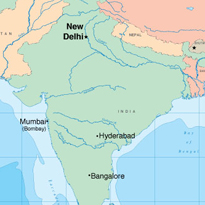A matter of scale
Friday morning (and evening)
India is a big place, both in terms of geographic size and population. In many ways size means strength, such as in the rich cultural diversity to be found in India or the enormous (at least half a billion people) and growing labor force in the country.
A large population also means that when there are challenges in society, the scale of the problem can be daunting, making solutions difficult to get your arms around. That’s the case when it comes to education at both the secondary and post-secondary level, according to many of the people with whom we’ve met on the trip.
For example, while India produces some outstanding college graduates, especially in technical fields such as engineering and computer science, only about 15 percent of Indian students attend college, Shri Kapil Sibal, India’s dynamic Minister of Human Resource Development told us yesterday. Sibal, who also serves as India’s chief education official and is leading the effort to open India’s higher education system to foreign universities to a greater degree, would like to see that figure move to 30 percent over the next 10 years.
To do that, Sibal figures India will need to open 800 new institutions of higher education, which leads to some obvious questions: How do you greatly expand a country’s higher education system quickly while maintaining the quality necessary to produce the large number of employable graduates India will need to continue its economic growth in the future? Who is going to pay for it? And where will the faculty come from in a country that already has a dearth of teachers at every level?
The same themes were echoed this afternoon by Vice President Shri M. Hamid Ansari and again this evening by noted IU alumnus Dr. Narendra Jadhav, who is a member of the national Planning Commission in India and one of his country’s leading statesmen.
In his remarks after receiving the Thomas Hart Benton Medal from President McRobbie for his outstanding service to India, Dr. Jadhav spoke passionately on the challenges of nearly doubling the percentage of college students in India while improving the quality of the higher education system. It’s a challenge, he says, that can only be met by the government and private sector working together.
Partnerships between foreign universities, such as IU, and Indian institutions that result in student exchanges, faculty collaboration and even joint degree programs are all helpful, but Minister Sibal made it clear that he thinks such activities are only a first step it comes to filling India’s daunting higher education needs. Distance education brings with it inherent quality control concerns, Sibal argues, and paying foreign faculty a premium to come to India to help fill the faculty gap would be political untenable in a country where professorial salaries are largely set and funded by the government.
The prospect of U.S. or other foreign institutions setting up campuses in India or partnering with foreign universities in larger ways than most collaborations today holds some promise for Sibal, but building brick-and-mortar facilities is an expensive proposition for a foreign university, especially in times of reduced government funding and economic distress.
So, where does that leave the future of India’s higher education system? It seems clear that it’s not a problem that can be solved today or even tomorrow, but it’s heartening to see so many smart, committed people working on the issue.
In addition to thoughtful leaders like Sibal, Ansari and Jadhav leading Indian business executives also are tackling the issue in various ways. The Azim Premji Foundation, named for the founder of Wipro one of India’s largest IT companies, has committed approximately $2 billion to the cause of improving the quality of teaching in India at all levels and is even creating its own university to train future generations of educators.
We met with a leader with the Azim Premji Foundation while in Bangalore, who laid out his organization’s ambitious plans, the scale of which border on the audacious – but maybe that’s what it takes to meet a challenge of this magnitude. Today, we celebrated the start of a two-day conference between IU and OP Jindal Global University. JGU is a private university started by Naveen Jindal who runs Jindal Steel and Power Co., which is part of the Jindal Group, a nearly $1 billion organization. The university was started less than three years ago to promote public service through education, and IU and Jindal formalized a partnership tonight.
Jindal University is another bold stroke backed by one of India’s most successful business executives who is committed to give back. And maybe in that lies the answer to India’s formidable education challenges. It’s going to take a lot of people doing their part – and inviting like-minded partners from around the world to do what they can to join in the movement. Maybe efforts like ours in India are just a first step, but every journey has to start somewhere.
Tags: Hamid Ansari, Narendra Jadhav, OP Jindal Global University
1 Comment
Sorry, the comment form is closed at this time.




I really appreciate this post. Thank you very much.
Comment by Adam Jonas on January 24, 2012 8:45 am